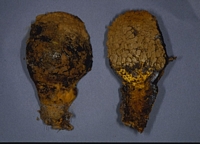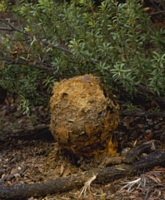Pisolithus sp. 10
|
 | Pisolithus ‘species 10’ is a ‘tagname’
for a species that has not
been formally named. Showing the
fruiting body in section (right) with
the mosaic-like clumps of developing
spore masses (peridioles) separated
by dark walls. The upper spor |  | All 3 species of Pisolithus in New Zealand are known only from the central North Island geothermal region where they are mycorrhizal on the roots of tea-tree. |
|

|

|